by Lisha Vidler
(Click any photo to view a larger image.)
Have you seen the world-famous production of Andrew Lloyd Webber’s The Phantom of the Opera? Everything about it is breathtaking! The story—a heartrending tale of passion and unrequited love. The music—unforgettable! And the costumes . . . ah, the costumes. The designer, Maria Björnson, used lustrous silks and brocades, lace, embroidery, and beaded appliques, heaping them together in a way that’s both gaudy and supremely elegant.
There are several productions of Phantom around the world, including a newly revised tour that’s traveling across the United States. There’s also an exhibit of costumes accompanying the tour.
In this two-part article, we’ll take a closeup look at the costumes featured in the exhibit. But first, let me explain why these costumes mean so much to me.
My Obsession
Twelve years ago, I discovered The Phantom of the Opera. Oh, I’d heard the music before—who hasn’t? But I’d never paid that much attention to it. My fiance (now husband) woke me up one morning by playing “All I Ask of You” on the piano. Talk about romantic!
Fast forward two years, to the premiere of the Schumacher film. As soon as my husband showed me the preview, I knew it was going to be something spectacular. We drove through an ice storm to get to the movie theater—another memory that will stay with me forever.
I went out and bought the soundtracks to both the movie and the original London cast recording. But it wasn’t enough! I searched for a good translation of the original novel by Gaston Leroux, as well as sequels, prequels, and alternate versions. I watched every film I could find, including the Lon Chaney silent film and the miniseries starring Charles Dance.
But nothing could supplant Andrew Lloyd Webber’s masterpiece.
Around this time, I began to get serious about sewing. I discovered there were fans sewing their own versions of the costumes from the stage show, such as Anéa and Michaela de Bruce. Even though I hadn’t yet seen the stage version, I loved the various costumes and wanted to make my own. I set out to learn all I could about them. My dream of seeing the costumes in person wasn’t very realistic, but I studied Maria’s original sketches. I pored over video clips and photographs. I spent hours discussing the details with fans who’d been backstage and examined the costumes for themselves, including one who happened to own several retired costumes.
As soon as I knew enough to get started, I began sewing my own replicas of the costumes. First, I made Christine’s blue “Wishing” dress, the costume she wears during the graveyard scene. It turned out pretty good, considering how little I actually knew about dressmaking! I wore it to see the show in Birmingham, Alabama, which turned out to be one of the most exciting experiences of my life.
I vowed to make my own version of every major costume, but I simply didn’t have the resources—or the room to store them! So, I scaled back my plans, quite literally, and began making doll-sized replicas. First, I made the Hannibal ballet costume to fit an 11 ½” Barbie doll. Later, I made the same costume for the 15 ½” fashion doll, Gene Marshall.
After that, I sewed the skirt Christine puts on over the Hannibal leotard for her astonishing debut as Elissa, when she sings “Think of Me.”
I also made the ruffled dress Christine wears during “Point of No Return,” while playing the role of Aminta.
I’m currently working on a new version of Aminta’s dress, for a much larger doll. I also have plans to make doll-sized replicas of Christine’s white dressing gown, as well as the “Wishing” dress, “Masquerade” costume, the wedding gown, and the mint green and pink ballet costume worn during “Il Muto.”
I even bought a male fashion doll, so I can make the Phantom’s costume, too.
Given my obsession, perhaps you’ll understand why I got so excited when I learned that, in anticipation of the tour’s arrival in Memphis, some of the costumes were being exhibited in a vacant storefront.
There were six costumes on display:
- The Footman’s Livery
- Hannibal Slavegirl
- Piangi’s Hannibal Armor
- The Phantom’s Suit and Cloak
- Christine’s Aminta Dress (“Point of No Return”)
- Carlotta’s Silver & Black Dress (“Prima Donna”)
The volunteer overseeing the exhibit said they were “the original costumes from twenty-five years ago.” I recognized them as being from an American production, but the details didn’t quite match the costumes from the original Broadway show. According to Anéa, the world-renowned expert on Phantom costuming, they’re likely no more than ten years old.
Interestingly, these costumes are not the same as those worn in the current US Tour, despite the fact that the exhibit is part of the Tour. In fact, many of the costumes from the new tour were borrowed from the revamped London Tour of 2012.
Despite the confusion about the costumes’ age and origins, each one was exquisite. Some displayed extreme signs of wear—they’d definitely been worn onstage!
Let’s take a look, shall we?
-
A Note on the Photos
Every picture in this article is protected under US copyright law and cannot be used without permission. You may save them for personal use and research, but you may not publish them anywhere—that includes your website or blog. If you want to share the pictures with others, please give out the link to this article!
WordPress has a file size limit, so all the photos displayed in this article are scaled down. If you would like to see the full-sized photos, contact me and briefly explain why you need the pictures. So long as you promise not to violate my copyright by publishing the images, I’ll send you a zip file containing all of the original photos.
The Footman: 18th Century Livery
This costume belongs to a Footman who appears at the Opera during the “Masquerade” scene in Act II, offering drinks to Messieurs Firmin and Andre. It’s an 18th century-style suit of red velvet and cream brocade, with lace ruffles and oodles of gold Venetian lace appliques. It’s usually worn with white stockings, gold court shoes, and a powdered wig. According to the description placard, it’s based upon the actual livery worn by employees at the Paris Opera. (The original fashion sketch can be found here.)
- Shirt
Though most of the shirt is hidden by the waistcoat and jacket, a bit peeks out at the neckline. It’s white, with a wingtip collar, vertical lace ruffles, and gold-rimmed mother-of-pearl buttons. (I suspect it may be a dickey—just the collar and front bit, with no sleeves.)
- Breeches
Knee-length trousers made of cream brocade shot with gold. They fasten at the knees with gold bands.
- Waistcoat
Made of cream brocade and decorated with intricate gold appliques to simulate rich embroidery. It has faux pockets, which are embellished with gold appliques. The edges of the waistcoat have gold piping, and ornate gold buttons fasten the front.
- Tailcoat
Made of dark red velvet. Gold appliques are sewn along the front edges, down the back of the sleeves, and on the back tails. The faux pockets are accented with more gold appliques. Double lace ruffles peek out from the sleeves—these are attached separately, not part of the shirt. Gold buttons run down both sides of the tailcoat’s front, obviously decorative, not functional.
Hannibal Slavegirl (aka the Hannibal Ballet Costume)
A slave costume worn by chorus members during the dance sequence at the beginning of Act I, a rehearsal of the Opera’s new production of “Hannibal.” It consists of a red and green velvet bodice, and a skirt made of slashed velvet “ropes” and beaded strands. It’s traditionally worn with flesh-colored tights and pointe shoes, along with a jeweled tiara and cuff bracelets. (The original fashion sketch can be found here.)
Although Christine wears a similar ballet costume during this scene, her costume is more richly embellished, with gold bust cups draped with strands of beads. It’s possible this costume was worn by Meg—certain photos show that her ballet costume is nearly identical to the one at the exhibit. There are minor differences, though, so it seems more likely this outfit was worn by one of the chorus dancers.
- Bodice
Even though I made my doll version with a full leotard, the actual costume uses a bodice with separate panties underneath, which were absent from the display. The bodice is made of color-blocked velvet panels that alternate between red and green. The seams are covered with gold trim and, except for the sides, are embellished with red and green “jewels.” (These colored gems are not found on the London version of the costume, which use more ornate gold braid for the vertical decorations.)
Normally, there are beaded strands that drape around the shoulders, but these are missing, most likely removed when the costume was put into storage. The edges of the bodice are piped with gold.
- Breastplate
Different productions use different designs for the breastplate. This one features a scalloped red background (I believe it may have been felt) covered with gold filigree pieces, as well as opaque gold and green jewels and amber crystals.
The costumes used in the current US Tour use the London design, whose breastplates have a background of gold lace or appliques, with jeweled embellishments. (As seen here.)
- Skirt
The skirt is made of red and green velvet ropes, which are made of strips of slashed velvet that match the color-blocking of the bodice. It appears as if they are cut double the necessary length, then folded in half and knotted at the top, where they’re attached to the underside of the bodice.
The bottoms of the rope strands are striped with red, green, and yellow.
The London-style ballet skirts, used in the current US Tour, have red and green strands that don’t match the color-blocking of the bodice, but are mixed randomly together. The stripes at the bottom are absent, as well. (As seen here.)
In both versions, the front panel of the skirt is made of red and green beaded strands interspersed with knotted gold rope strands. I noticed that the knots in the gold ropes are clustered haphazardly, as if someone tied them in a hurry.
- Belt
A belt made of looped gold braid wraps around the hips. At the front is a red crescent-shaped piece, officially known as the “crotch tiara,” which is covered with gold filigree, and red and green jewels. London’s version of the belt is usually black with a gold mesh or woven braid. The London “crotch tiara” is made of gold appliques, with a few jeweled accents. (As seen here.)
A simpler version of the crescent, officially referred to as the “butt tiara,” is mounted in the back. Instead of gold filigree, it’s decorated with metallic gold Venetian lace appliques, and edged with gold picot braid.
While quite lovely, this is a rather poor example of this costume. Not only is it faded and worn, but important elements (such as the beaded shoulder straps) are missing. I did notice some interesting details about it, though.
First, it fastens at the center front, whereas the London version uses hooks to close down the back. (As seen here.) Instead of hooks, this costume has black lacing that crisscrosses down the center back, allowing the costume to be adjusted to fit each dancer.
In the front, the breastplate overlaps at the middle of the chest and snaps closed, almost like a surplice bodice. You can just see this detail in the closeup photo below.
When I sneaked around to see the back of the costume, I discovered a strange configuration of elastic straps. The flesh-colored straps go over the shoulders, like you’d expect, but then they extend diagonally across the shoulder blades. I couldn’t imagine why, but as Anéa explained, they are most likely to ensure that the elastic shoulder straps don’t slip off during the dance sequence.
The elastic straps have a wavy design sewn onto them, which I thought was a pretty touch. No one will ever see it from the audience!
I also found a mysterious snap on the inside of the bodice, right where the neckline meets the left shoulder strap. There wasn’t one on the right side, so I have no idea what this snap could be for.
Piangi’s Hannibal Armor
A Carthaginian suit of armor worn by Ubaldo Piangi when he plays the role of Hannibal, during the rehearsals in the beginning of Act I. It’s usually worn with a plumed helmet, cuffed bracelets, and lace-up sandals. (See the original fashion sketch here.)
Since it’s so layered, it’s hard to tell what the individual pieces might be, but it seems to have an under-tunic, a belt with hanging tabs, a skirt, and an armored breastplate. Each piece is richly embellished in a style that’s remarkably similar to Carlotta’s dress from this scene—the Elissa dress, which, sadly, wasn’t on display.
- Under-Tunic
The tunic is made of a striking green and black brocade. The kimono sleeves are trimmed with bands of black and gold, and edged with long, metallic gold fringe. It has a V-neckline that’s filled in with a triangular flesh-colored panel.
- Belt & Tabs
A scarf-like belt wraps around the waistline, made of gold fabric and edged with a design of black, red, and green. It reminds me of Carlotta’s scarf, which she uses to flirt with the managers, during her abbreviated rendition of “Think of Me.” At the front of the belt is a circular gold emblem studded with red and green jewels. Hanging from the sides and back are antiqued gold medallions, arranged in a triangular pattern. (See the back view for a closeup of the medallions.)
Hanging from the front of the belt are two pointed tabs, whose design echoes the tabs on Carlotta’s costume from this scene. These tabs have a gold, red, green, and black geometric design that’s emphasized with matching jewels. The pointed ends are edged with gold fringe.
- Skirt
The masculine skirt has an antique-gold mesh panel that extends to mid-thigh. Below it hangs a section of wide ribbons that interlock in a diamond pattern, decorated with gold studs and red jewels. Hanging from the bottom points are large tassels that alternate between red and green, overlaid with gold. Again, this is highly reminiscent of Carlotta’s skirt. Underneath the diamond ribbon overlay is a panel that seems to be a dark, printed fabric—perhaps a batik or sari material.
- Armored Breastplate
The armor is sculpted to fit Piangi’s rather rotund figure. It’s painted an antiqued bronze, and has a repeating circular motif. Wide black straps cross over the shoulders to support the armor.
~~*~~
In the second half of this article, we’ll examine the Phantom’s suit and cloak, Christine’s Aminta dress, and Carlotta’s “Prima Donna” dress.

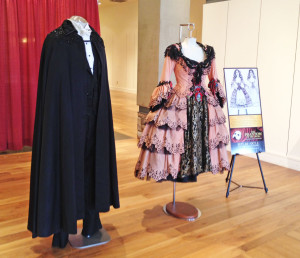
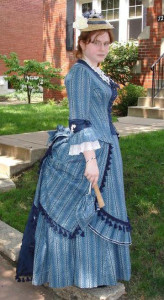
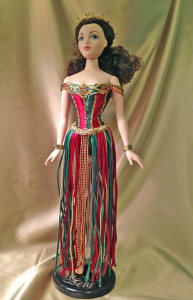
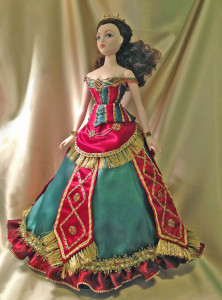
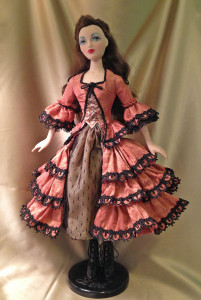
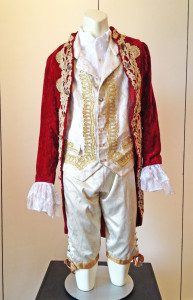
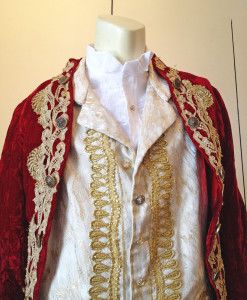
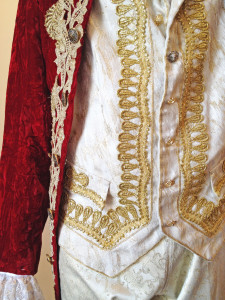
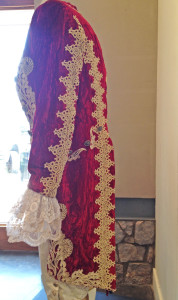
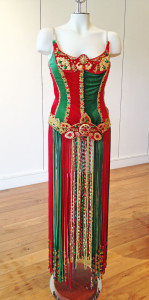
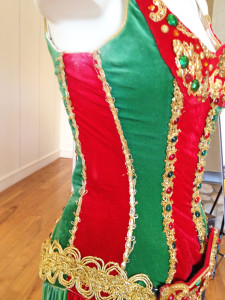
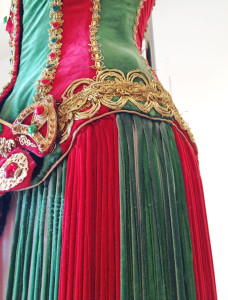
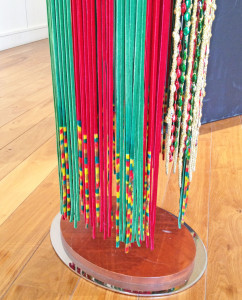
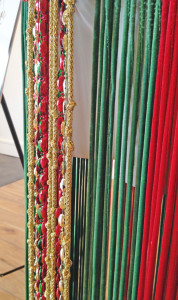
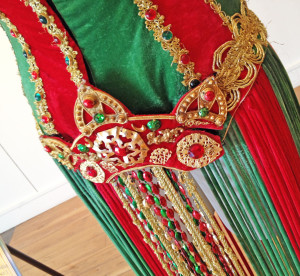
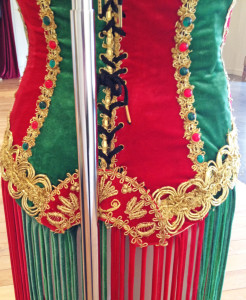
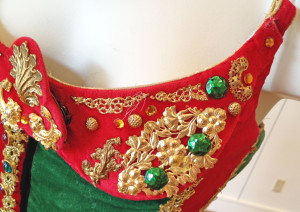
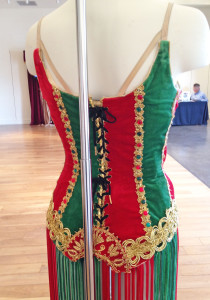
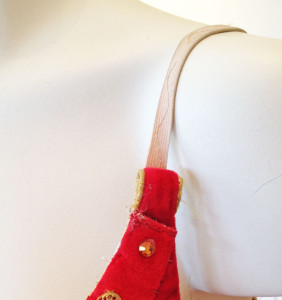
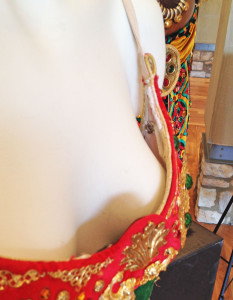
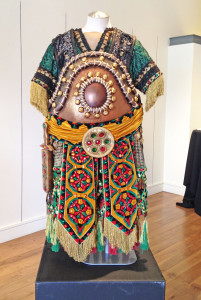
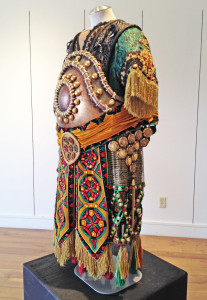
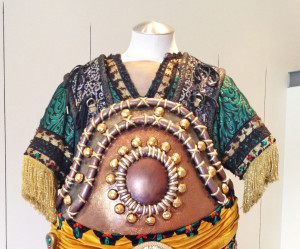
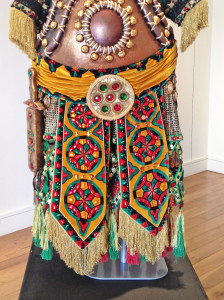
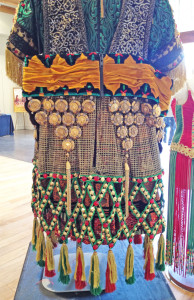
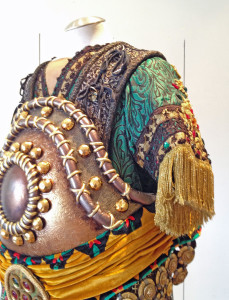
Do you have anymore pictures of the slave girl costume from Hannibal? Also do you have photos of Elissa’s skirt? I am trying to reproduce the costume. Sadly there are no dress patterns, so I have to figure it out from photos. Thank you so much! (Your photos are soooo helpful!)
Have you visited Anea’s site? (http://potocostumes.webs.com/) She has photos and descriptions of all the different Phantom costumes from around the world! Each page has a detailed description, plus a link to a photo gallery for that costume. She’s made replicas of many of the costumes, including the Elissa skirt, so she might be able to help.
Now, I have a zip file of photos from the exhibit–they’re the same photos from the article, just hi-res. (The Elissa skirt was not displayed at the exhibit.) I can send those, if you’d like. I also have a TON of pictures I found online of the Elissa skirt and the Hannibal ballet costume, but I can’t post them on my site for copyright reasons. I could send them to you privately, though! Also, I made a doll-sized version of the slave girl ballet costume and the Elissa skirt, if you’d like to take a look at those. (They can be found in my Portfolio.)
Have fun with your costume! I’d love to see it when you’re done.
I’m guessing the mystery snap in the Hannibal slavegirl costume has to do with removable “sweat pads” that can snap and unsnap to be washed. They help soak up sweat and preserve the costumes (obviously). When I worked “Shrek the Musical,” all of the costumes had these.
Pingback: My Homepage
Where can I buy the dolls 😭
If you’d like to make one of your own, you can buy a “Simply Gene” doll on eBay. I don’t know what they sell for now, but I paid about $40 each for mine, about ten years ago.